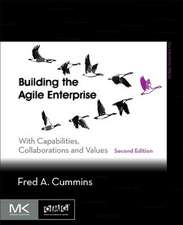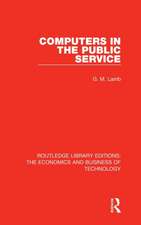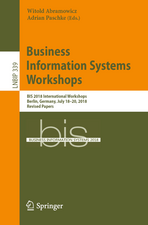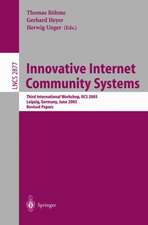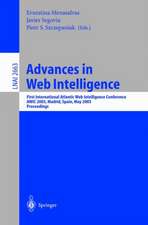Filtering the Web to Feed Data Warehouses
Autor Witold Abramowicz, Pawel J. Kalczynski, Krzysztof Wecelen Limba Engleză Paperback – 10 sep 2012
- how to use data warehouse for filtering Web content
- how to retrieve relevant information from diverse sources on the Web
- how to handle the time aspect
- how to mechanically establish links among data warehouse structures and documents filtered from external sources
- how to use collected information to increase corporate knowledge
and gives a comprehensive example, illustrating the idea of supplying data warehouses with relevant information filtered from the Web.
| Toate formatele și edițiile | Preț | Express |
|---|---|---|
| Paperback (1) | 331.74 lei 6-8 săpt. | |
| SPRINGER LONDON – 10 sep 2012 | 331.74 lei 6-8 săpt. | |
| Hardback (1) | 337.20 lei 6-8 săpt. | |
| SPRINGER LONDON – 24 iul 2002 | 337.20 lei 6-8 săpt. |
Preț: 331.74 lei
Preț vechi: 414.67 lei
-20% Nou
Puncte Express: 498
Preț estimativ în valută:
63.48€ • 66.28$ • 52.42£
63.48€ • 66.28$ • 52.42£
Carte tipărită la comandă
Livrare economică 15-29 aprilie
Preluare comenzi: 021 569.72.76
Specificații
ISBN-13: 9781447111078
ISBN-10: 1447111079
Pagini: 284
Ilustrații: XII, 267 p.
Dimensiuni: 155 x 235 x 15 mm
Greutate: 0.4 kg
Ediția:Softcover reprint of the original 1st ed. 2002
Editura: SPRINGER LONDON
Colecția Springer
Locul publicării:London, United Kingdom
ISBN-10: 1447111079
Pagini: 284
Ilustrații: XII, 267 p.
Dimensiuni: 155 x 235 x 15 mm
Greutate: 0.4 kg
Ediția:Softcover reprint of the original 1st ed. 2002
Editura: SPRINGER LONDON
Colecția Springer
Locul publicării:London, United Kingdom
Public țintă
ResearchCuprins
1 Introduction.- 1.1 Information Systems.- 1.2 Information Filtering Systems.- 1.3 Database Systems.- 1.4 Organization of this Book.- 2 Data Warehouse: Corporate Knowledge Repository.- 2.1 Introduction.- 2.2 Data Warehouse Definition and Features.- 2.3 Data Warehouse System.- 2.4 Deploying Data Warehouse in the Organization.- 2.5 Knowledge Management in Data Warehouses.- 2.6 Evolution of the Data Warehouse.- 2.7 Chapter Summary.- 2.8 References.- 3 Knowledge Representation Standards.- 3.1 Introduction.- 3.2 Markup Languages.- 3.3 Dublin Core.- 3.4 Warwick Framework.- 3.5 Meta Content Framework.- 3.6 Resource Description Framework.- 3.7 Common Warehouse Metamodel.- 3.8 Chapter Summary.- 3.9 References.- 4 Information Filtering And Retrieval From Web Sources.- 4.1 Introduction.- 4.2 Information Retrieval Systems.- 4.3 Information Filtering Systems.- 4.4 Internet Sources of Business Information.- 4.5 Filtering the Web to Feed Business Information Systems.- 4.6 Chapter Summary.- 4.7 References.- 5 Enhanced Data Warehouse.- 5.1 Introduction.- 5.2 Justification of the Need for Integration.- 5.3 Preliminary Vision of the System.- 5.4 Software Agents.- 5.5 Proposed Solution: enhanced Data Warehouse.- 5.6 Formal Model of eDW.- 5.7 System Implementation.- 5.8 Chapter Summary.- 5.9 References.- 6 Profiling.- 6.1 Introduction.- 6.2 Personalization and Data Warehouse Profiles.- 6.3 Algorithms Specification.- 6.4 Profiling Server.- 6.5 Chapter Summary.- 6.6 References.- 7 Source Exploitation.- 7.1 Introduction.- 7.2 Sample Business Content Providers.- 7.3 Information Ants to Filter Information from Internet Sources.- 7.4 Indexing Parser.- 7.5 Transparent Filtering in the eDW System.- 7.6 Chapter Summary.- 7.7 References.- 8 Building Data Warehouse Library.- 8.1 Introduction.- 8.2 Time Indexing.- 8.3 Experiment with Time Indexing.- 8.4 Future Trends: Multimedia Indexing.- 8.5 Chapter Summary.- 8.6 References.- 9 Context Queries And Enhanced Reports.- 9.1 Introduction.- 9.2 Context Queries.- 9.3 enhanced Report.- 9.4 Reporting Application.- 9.5 Histograms: The Helpful Tool for Analysis.- 9.6 Chapter Summary.- 9.7 References.- 10 Conclusions.- 10.1 Concluding Remarks.- 10.2 Improvements.- 10.3 Open Issues and Future Work.
Caracteristici
Extends the functionality of the data warehouse by loading it with relevant (filtered) unstructured content Includes state-of-the-art survey on information filtering techniques

